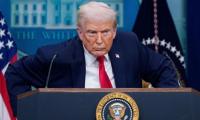How the US jobs report managed to surprise almost everyone
The monthly US jobs report can often produce big surprises, but the one on Friday was colossal in its scale, with almost everyone caught off-guard.
From Wall Street economists to Trump administration officials and Federal Reserve policymakers, there was a widespread belief that the US had suffered additional job losses — as many as 8m — last month.
Instead, employers were actually bringing back a fraction of idled workers to their payrolls, to the amount of a net 2.5m jobs, raising questions about why the forecasts could be so wrong and whether a sustainable recovery was truly under way.
The encouraging data certainly revived hopes that the US might experience a speedier and perhaps even stronger rebound from the coronavirus shock than assumed, with the trough occurring in April rather than later in the spring. But it does not mean that the economy is in the clear.
“We’ve fallen a long way here, and we’ve started to make some progress back,” said Aaron Sojourner, a labour economist and associate professor at the University of Minnesota school of management. “The first part of the way back is relatively easy, the middle part gets harder, and the last stretch is not going to be for a while.”
Last month’s gains in employment were spread across a wide variety of industries, as some states began to lift restrictions on economic activity. Leisure and hospitality — including restaurants — clawed back 1.2m jobs after losing more than 8m since the crisis began, while retailers brought back 377,000 jobs out of more than 2.3m lost earlier in the year.
But those restored positions amount to only a fraction of the cumulative 22m jobs lost earlier in the year, and the unemployment rate, at 13.3 per cent, remains well above its 10 per cent peak following the 2009 financial crisis.
“With more states moving to loosen their lockdowns in the coming weeks, particularly in the populous north-east, employment looks set to continue rebounding in June and beyond, although we still think it will be a long time before the labour market is anywhere near back to its pre-virus state,” Capital Economics wrote in a note.
One of the reasons economists and officials were surprised by the jobs report for May is that it jarred with weekly figures showing mounting applications for unemployment benefits throughout the month.
Mr Sojourner said the jobless claims only showed the negative component of the labour market, which is rapidly recorded by the government as it processes applications, whereas there is no similar high-frequency data for hiring. “There isn’t good systematic visibility into the upside,” he said.
There were also some quirks in the numbers that suggested caution. The labour department said the unemployment rate would have been 3 percentage points higher if not for a “misclassification error” that resulted in people being recorded as employed but absent rather than temporarily laid off.
The department said the Bureau of Labor Statistics and the Census Bureau “are investigating why this misclassification error continues to occur and are taking additional steps to address the issue”.
In addition, there has also been a worrying exodus from the labour force as Americans lose hope that they can find a job during the pandemic. Disruptions in the way the data was collected also meant that a smaller percentage of businesses and households responded to government surveys than was the case before the outbreak.
“The temporary labour market problems are very deep and . . . even if individuals on temporary lay-off returned to work very quickly the United States would still have a recessionary level of unemployment for some time to come,” wrote Jason Furman of the Peterson Institute for International Economics and Wilson Powell III of the Harvard Kennedy School.
Sophia Koropeckyj, managing director at Moody’s Analytics, said: “Employment will improve through the third quarter. After that we will have regained about half of lost jobs. The unemployment rate will end the year at about 10 per cent. A full recovery will not occur in earnest until a vaccine is widely available by the second half of 2021.”
The brighter outlook for the labour market could also be dented by other risks on the horizon, such as the possibility of a new wave of infections and economic disruptions resulting from the mass protests against racial injustice and police brutality in many US cities. In addition, there is huge uncertainty over whether small businesses will continue to keep workers on payrolls after they have spent loans and grants from the government that were part of $3tn in stimulus measures passed since the crisis began.
Chuck Schumer, the top Democrat in the US Senate, said he worried that the better than expected job numbers might discourage Republicans from agreeing to additional stimulus measures.
“With nearly 20 million people out of work and unemployment among African-Americans increasing, now is not the time to be complacent or take a victory lap,” he said. “In order to avoid the risk of another great depression, Senate Republicans ought to stop sitting on their hands and work with Democrats to immediately pass legislation to make sure that everyone in America has the income and job security they need to feed their families and put a roof over their heads.” —The Financial Times Limited 2020
-
 Alexander Skarsgard Breaks Silence On Rumors He Is Bisexual
Alexander Skarsgard Breaks Silence On Rumors He Is Bisexual -
 King Charles Faces Rift With Prince William Over Prince Harry’s Invictus Games
King Charles Faces Rift With Prince William Over Prince Harry’s Invictus Games -
 Elon Musk’s Critique On ChatGPT Safety Draws Sharp Response From Sam Altman
Elon Musk’s Critique On ChatGPT Safety Draws Sharp Response From Sam Altman -
 Katherine Ryan Takes Aim At Brooklyn Beckham In Fierce Defense Of His Parents
Katherine Ryan Takes Aim At Brooklyn Beckham In Fierce Defense Of His Parents -
 How Timothy Busfield, Melissa Gilbert Really Feel After Release From Jail
How Timothy Busfield, Melissa Gilbert Really Feel After Release From Jail -
 OpenAI, Bill Gates Launch ‘Horizon 1000’ To Transform AI Healthcare In Africa
OpenAI, Bill Gates Launch ‘Horizon 1000’ To Transform AI Healthcare In Africa -
 Prince Harry Receives Praises For Exposing Dark Side Of British Tabloids
Prince Harry Receives Praises For Exposing Dark Side Of British Tabloids -
 Andrew Forces Beatrice, Eugenie To Lose $60 Million Safety Net Saved For Retirement
Andrew Forces Beatrice, Eugenie To Lose $60 Million Safety Net Saved For Retirement -
 Nvidia CEO Jensen Huang To Visit China To Push Re-entry Into AI Chip Market
Nvidia CEO Jensen Huang To Visit China To Push Re-entry Into AI Chip Market -
 U.S. On Verge Of Losing Measles-free Title Due To Outbreak
U.S. On Verge Of Losing Measles-free Title Due To Outbreak -
 Harry Styles Excites Fans As He Announces Release Date Of New Song
Harry Styles Excites Fans As He Announces Release Date Of New Song -
 Japan’s Ex-PM Shinzo Abe’s Killer Is Set To Be Sentenced: How Much Punishment Could He Face?
Japan’s Ex-PM Shinzo Abe’s Killer Is Set To Be Sentenced: How Much Punishment Could He Face? -
 Prince Harry, Meghan Markle’s Return To UK Could Create Royal Family Dilemma
Prince Harry, Meghan Markle’s Return To UK Could Create Royal Family Dilemma -
 Prince Harry Turns Troubled With No Sense Of Home: ‘Isolation Is Getting To Him Mentally’
Prince Harry Turns Troubled With No Sense Of Home: ‘Isolation Is Getting To Him Mentally’ -
 Vitamin D Link To Respiratory Diseases Will Shock You
Vitamin D Link To Respiratory Diseases Will Shock You -
 A$AP Rocky Gives His Take On Children's Budding Personalities
A$AP Rocky Gives His Take On Children's Budding Personalities



